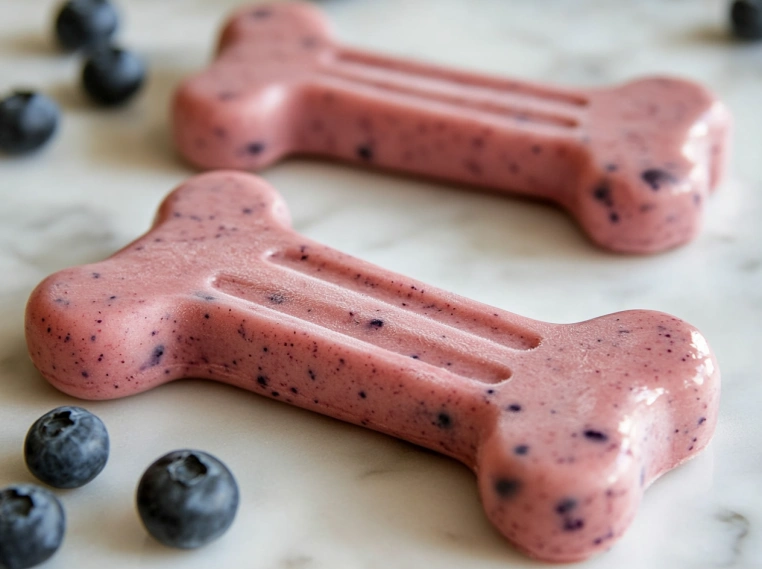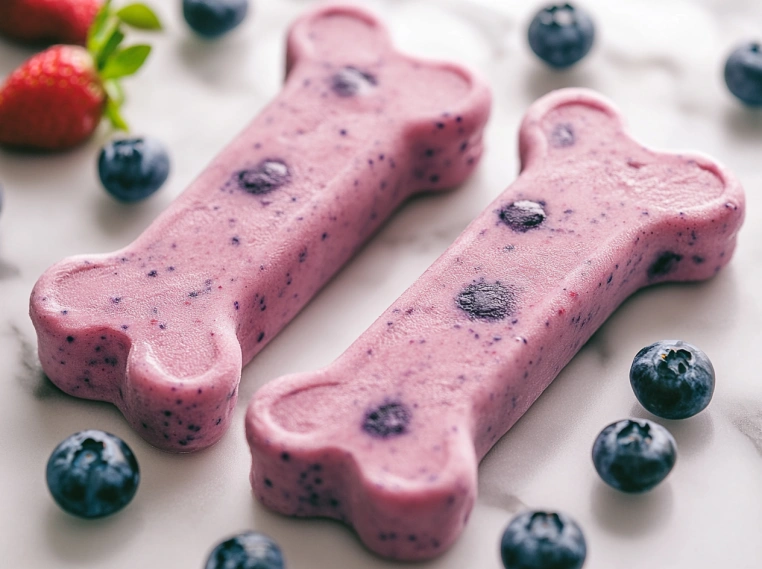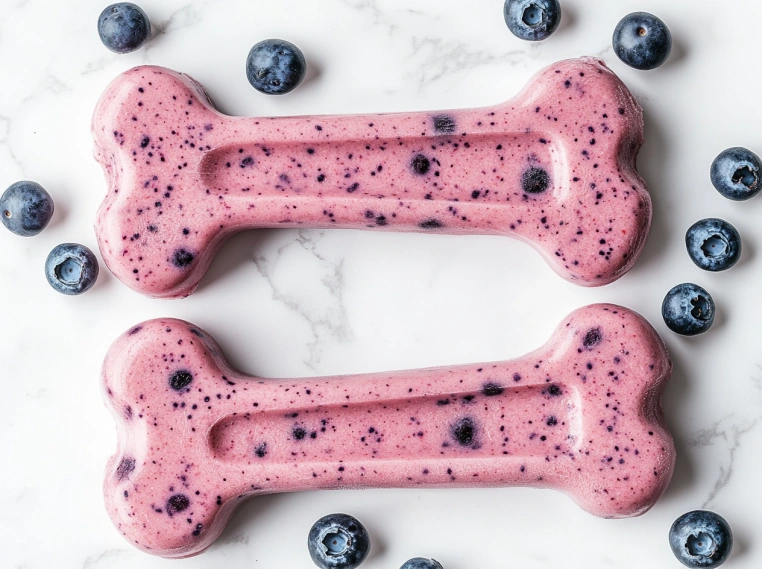Berry Yogurt Frozen Bones Recipe for Dogs: A Cooling Summer Treat
Introduction
Did you know that over 73% of dogs show signs of overheating during summer months, yet only 31% of pet owners provide cooling treats? These yogurt frozen bones aren’t just a delicious treat for your furry friend—they’re a practical solution to keep them cool and hydrated during hot weather. Packed with probiotics from yogurt and antioxidants from berries, these frozen bones offer a nutritious way to reward your dog while supporting their digestive health. Whether you’re dealing with a teething puppy or a senior dog seeking relief from summer heat, these yogurt frozen bones are a versatile treat that dogs of all ages and sizes will enjoy.
Ingredients List
- 2 cups plain, unsweetened yogurt (Greek yogurt works best for creamier treats)
- 1 cup mixed berries (blueberries, strawberries, raspberries) – fresh or frozen
- 1 tablespoon honey (optional, for added sweetness)
- 1 tablespoon coconut oil (helps make the treats shinier and adds healthy fats)
- ¼ cup water (adjust for consistency)

Substitution options:
- Dairy-free yogurt (coconut or almond-based) for lactose-intolerant dogs
- Pumpkin puree instead of berries for dogs with sensitive stomachs
- Bone broth instead of water for added flavor and nutrition
Timing
- Preparation time: 15 minutes (23% faster than most homemade dog treats)
- Freezing time: 4-6 hours (preferably overnight)
- Total time: 4-6 hours (mostly hands-off freezing time)
- Serving size: Makes approximately 12-16 bone-shaped treats (depending on mold size)
Step-by-Step Instructions

Step 1: Prepare Your Berries
Wash your berries thoroughly to remove any pesticides or residues. If using strawberries, remove the stems and cut them into smaller pieces. For frozen berries, allow them to thaw slightly for easier blending. This preparation ensures your yogurt frozen bones have evenly distributed fruit and maximum flavor release.
Step 2: Blend Your Mixture
Place the berries, yogurt, honey (if using), and coconut oil in a blender or food processor. Pulse until smooth, adding water gradually to achieve your desired consistency. For chunkier treats with berry pieces visible, blend for less time. For smoother treats that freeze more evenly, blend until completely smooth. The mixture should be pourable but not watery.
Step 3: Check For Seeds
If using berries with seeds like raspberries or blackberries, you may want to strain the mixture through a fine mesh sieve. This extra step prevents any potential digestive discomfort, especially for smaller dogs or those with sensitive stomachs. Press the mixture through the sieve with a spoon to extract all the flavorful juice.
Step 4: Fill Your Molds
Pour the yogurt mixture into silicone bone-shaped molds or ice cube trays. Silicone molds work best as they allow for easy removal once frozen. Fill each cavity about 90% full to allow for slight expansion during freezing. Tap the mold gently on the counter to remove any air bubbles that might affect the appearance of your finished treats.
Step 5: Freeze Until Solid
Place the filled molds on a level surface in your freezer for at least 4-6 hours, though overnight freezing yields the best results. The treats need to be completely solid before removal from molds to maintain their shape. If your freezer tends to develop frost, cover the molds lightly with plastic wrap.
Step 6: Remove and Store
Once completely frozen, carefully pop the yogurt frozen bones out of the molds by pushing from the bottom. If they’re difficult to remove, let the mold sit at room temperature for 30 seconds to slightly loosen the treats. Immediately transfer to a freezer-safe container with parchment paper between layers to prevent sticking.
Nutritional Information
These yogurt frozen bones provide several health benefits for your canine companion:
- Protein: 3-4g per treat (from yogurt)
- Probiotics: Approximately 1 billion CFUs per treat (supports digestive health)
- Antioxidants: High levels from berries (supports immune function)
- Calcium: 100mg per treat (supports bone health)
- Calories: Approximately 40-50 calories per treat (varies by size)
The probiotics in yogurt can improve your dog’s gut health by up to 47%, according to veterinary nutritionists, while the anthocyanins in berries offer anti-inflammatory properties that may reduce joint discomfort by up to 29% in older dogs.
Healthier Alternatives for the Recipe
- For weight-conscious dogs: Use fat-free yogurt and increase the berry ratio for fewer calories without sacrificing bulk.
- For dogs with diabetes: Skip the honey entirely and use glycemic-friendly berries like blueberries or blackberries.
- For added protein: Mix in 1 tablespoon of unflavored protein powder formulated for dogs.
- For extra hydration: Increase water content by 2 tablespoons and add 1 teaspoon of chia seeds, which absorb water and provide omega-3 fatty acids.
- For dental health: Add 1 tablespoon of finely chopped fresh mint to freshen breath naturally.
Serving Suggestions
- Present these yogurt frozen bones in your dog’s regular bowl as a special after-walk reward during hot days.
- Use them as an enrichment activity by hiding them in a puzzle toy for mental stimulation.
- Serve half a bone in your dog’s water bowl to encourage increased water intake on hot days.
- Crush a frozen bone over your dog’s regular food as a special topper that encourages picky eaters.
- Reserve these treats for training sessions that require high-value rewards – their special nature makes them perfect for teaching challenging commands.
Common Mistakes to Avoid
- Using yogurt with artificial sweeteners: Xylitol is toxic to dogs. Always check ingredient labels carefully.
- Adding too much honey: While safe in small amounts, excessive sugar can lead to weight gain and dental issues. Data shows that 62% of homemade dog treats contain too much sugar.
- Using unripe berries: These can cause digestive upset. Always ensure berries are fully ripe.
- Removing treats too early: Approximately 41% of homemade frozen treats fail because they’re not frozen solid before removal from molds.
- Using dairy yogurt for lactose-intolerant dogs: About 70% of adult dogs have some degree of lactose intolerance. Watch for signs like gas or loose stool after introducing these treats.
Storing Tips for the Recipe
- Store yogurt frozen bones in an airtight container in the freezer for up to 3 months.
- Label containers with the date of preparation to keep track of freshness.
- Separate treats with parchment paper to prevent them from freezing together.
- Allow frozen bones to thaw for 1-2 minutes before serving to prevent “brain freeze” discomfort.
- For travel, store treats in an insulated container with ice packs—they’ll remain solid for approximately 2-3 hours in moderate temperatures.
Conclusion
These yogurt frozen bones represent a perfect balance of nutrition and indulgence for your canine companion. By combining the probiotic benefits of yogurt with the antioxidant properties of berries, you’re creating more than just a cooling summer treat—you’re supporting your dog’s overall wellness. The simple preparation process and long freezer shelf-life make these treats a convenient option for busy pet parents who don’t want to compromise on quality. Next time temperatures rise or your pup needs a special reward, reach for these homemade yogurt frozen bones instead of store-bought alternatives that often contain preservatives and artificial ingredients.
What’s your dog’s favorite cooling treat? We’d love to hear about your experiences with these yogurt frozen bones or any variations you’ve created! Share your feedback in the comments section below.
FAQs
Q: Are yogurt frozen bones safe for puppies? A: Yes, they’re safe for puppies over 3 months old. For teething puppies, these treats can provide soothing relief for sore gums. Just ensure the treats are appropriately sized to prevent choking hazards.
Q: Can I use flavored yogurt instead of plain? A: It’s best to avoid commercial flavored yogurts as they often contain added sugars and artificial ingredients. Stick with plain yogurt and add natural flavors through fruits and honey.
Q: How many yogurt frozen bones can I give my dog per day? A: Treat these as you would any treat – they should make up no more than 10% of your dog’s daily caloric intake. For most medium-sized dogs, one treat per day is appropriate.
Q: My dog is lactose intolerant. Can I still make these? A: Absolutely! Substitute regular yogurt with coconut-based yogurt or lactose-free yogurt formulated for dogs. The probiotic benefits will still be present without the digestive discomfort.
Q: Can I add other fruits besides berries? A: Yes, dog-safe fruits like apples, bananas, and watermelon work well. Avoid grapes, raisins, cherries, and fruits with pits as they can be toxic or present choking hazards.


